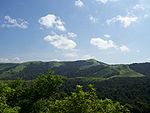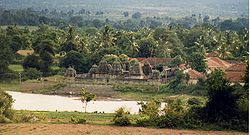
Economy of the Hoysala Empire
Encyclopedia

The Hoysala Empire was a notable South India
South India
South India is the area encompassing India's states of Andhra Pradesh, Karnataka, Kerala and Tamil Nadu as well as the union territories of Lakshadweep and Pondicherry, occupying 19.31% of India's area...
n empire that ruled most of the modern day state of Karnataka
Karnataka
Karnataka , the land of the Kannadigas, is a state in South West India. It was created on 1 November 1956, with the passing of the States Reorganisation Act and this day is annually celebrated as Karnataka Rajyotsava...
between the 10th to the 14th centuries. The capital of the empire was initially based at Belur
Belur
Belur may refer to any of the following:* Belur, Karnataka, town in Karnataka, India* Belur, West Bengal, India, a locality on the west bank of the Hooghly River* Belur Math, the religious abbey located in Belur, West Bengal, India...
, and later transferred to Halebidu
Halebidu
Halebidu is located in Hassan District, Karnataka, India. Halebidu was the regal capital of the Hoysala Empire in the 12th century. It is home to one of the best examples of Hoysala architecture in the ornate Hoysaleswara and Kedareswara temples. Halebidu literally means ruined city...
. Economy of Hoysala empire was primarily based on agriculture though business within India
India
India , officially the Republic of India , is a country in South Asia. It is the seventh-largest country by geographical area, the second-most populous country with over 1.2 billion people, and the most populous democracy in the world...
as well as foreign trade flourished to some extent.
Agriculture

Malnad
Malenadu is a region of Karnataka state in South India. Malenadu covers the western and eastern slopes of the Western Ghats, roughly 100 kilometers in width. Malenadu covers portions of the Shimoga, Chikmagalur, Uttara Kannada, Kodagu and Hassan districts....
regions) with its favorable climate was suitable for cattle farming, orchards and spices. Paddy and corn were staple crops in the plains (Bailnad). In Kannada country, key figures in rural areas were the rich land owners called gavunda or gauda and heggade. They are mentioned in inscriptions relating to land transactions, maintenance of irrigation, collection of taxes and works of village council. The gavunda of people (praja gavunda) was lower in status than the wealthy lord of gavundas (prabhu gavunda). The gavundas sometimes had a dual role as village representatives and appointees of the state. Some judicial responsibilities were also included like raising a militia if required.
Imports and Exports
Import of horses on the western seaboard was a flourishing business and inscriptions speak of Brahmin merchants who were active. ArabArab
Arab people, also known as Arabs , are a panethnicity primarily living in the Arab world, which is located in Western Asia and North Africa. They are identified as such on one or more of genealogical, linguistic, or cultural grounds, with tribal affiliations, and intra-tribal relationships playing...
s made wealth from the unending need for horses from Indian kingdoms. Rich forest produce like Teak
Teak
Teak is the common name for the tropical hardwood tree species Tectona grandis and its wood products. Tectona grandis is native to south and southeast Asia, mainly India, Indonesia, Malaysia, and Burma, but is naturalized and cultivated in many countries, including those in Africa and the...
was exported through ports of present day Kerela. Merchants from this region settled down in Arasikere and Halebidu in addition to Jain traders. Virgal (hero stone
Hero stone
Hero stone is a memorial commemorating the honorable death of a hero in battle of Tamil People. A hero stone can display a variety of adornments, including bas relief panels, statues, and figures of carved stone...
) in the coastal areas depict ships indicating active sea trade with shipping fleets. Piracy was common and Virgals made for fallen heroes have been found. Inscriptions mention a flourishing textile industry. Trade with overseas kingdoms reached unprecedented levels. Sung dynasty
Song Dynasty
The Song Dynasty was a ruling dynasty in China between 960 and 1279; it succeeded the Five Dynasties and Ten Kingdoms Period, and was followed by the Yuan Dynasty. It was the first government in world history to issue banknotes or paper money, and the first Chinese government to establish a...
records from China
China
Chinese civilization may refer to:* China for more general discussion of the country.* Chinese culture* Greater China, the transnational community of ethnic Chinese.* History of China* Sinosphere, the area historically affected by Chinese culture...
mention Indian merchants in ports of South China. Chinese
Chinese people
The term Chinese people may refer to any of the following:*People with Han Chinese ethnicity ....
interest in Indian astrology and Alchemy
Alchemy
Alchemy is an influential philosophical tradition whose early practitioners’ claims to profound powers were known from antiquity. The defining objectives of alchemy are varied; these include the creation of the fabled philosopher's stone possessing powers including the capability of turning base...
is well known. South India exported textiles, spices, medicinal plants, precious stones, pottery, salt made from salt pans, jewels, gold, ivory, Rhino horn, ebony
Ebony
Ebony is a dense black wood, most commonly yielded by several species in the genus Diospyros, but ebony may also refer to other heavy, black woods from unrelated species. Ebony is dense enough to sink in water. Its fine texture, and very smooth finish when polished, make it valuable as an...
and camphor
Camphor
Camphor is a waxy, white or transparent solid with a strong, aromatic odor. It is a terpenoid with the chemical formula C10H16O. It is found in wood of the camphor laurel , a large evergreen tree found in Asia and also of Dryobalanops aromatica, a giant of the Bornean forests...
to China. The same products reached ports like Dhofar
Dhofar
The Dhofar region lies in Southern Oman, on the eastern border with Yemen. Its mountainous area covers and has a population of 215,960 as of the 2003 census. The largest town in the region is Salalah. Historically, it was the chief source of frankincense in the world. However, its frankincense...
, Aden
Aden
Aden is a seaport city in Yemen, located by the eastern approach to the Red Sea , some 170 kilometres east of Bab-el-Mandeb. Its population is approximately 800,000. Aden's ancient, natural harbour lies in the crater of an extinct volcano which now forms a peninsula, joined to the mainland by a...
. In addition, aloe wood
Agarwood
Agarwood or oodh is a dark resinous heartwood that forms in Aquilaria and Gyrinops trees when they become infected with a type of mold...
, perfumes, Sandalwood
Sandalwood
Sandalwood is the name of a class of fragrant woods from trees in the genus Santalum. The woods are heavy, yellow, and fine-grained, and unlike many other aromatic woods they retain their fragrance for decades. As well as using the harvested and cut wood in-situ, essential oils are also extracted...
and condiments reached western ports like Siraf
Siraf
Siraf is a city in the Central District of Kangan County, Bushehr Province, Iran. At the 2006 census, its population was 3,500, in 722 families....
which was the entrypot to Egypt
Egypt
Egypt , officially the Arab Republic of Egypt, Arabic: , is a country mainly in North Africa, with the Sinai Peninsula forming a land bridge in Southwest Asia. Egypt is thus a transcontinental country, and a major power in Africa, the Mediterranean Basin, the Middle East and the Muslim world...
, Arabia and Persia. Cairo
Cairo
Cairo , is the capital of Egypt and the largest city in the Arab world and Africa, and the 16th largest metropolitan area in the world. Nicknamed "The City of a Thousand Minarets" for its preponderance of Islamic architecture, Cairo has long been a centre of the region's political and cultural life...
and Alexandria
Alexandria
Alexandria is the second-largest city of Egypt, with a population of 4.1 million, extending about along the coast of the Mediterranean Sea in the north central part of the country; it is also the largest city lying directly on the Mediterranean coast. It is Egypt's largest seaport, serving...
were in active trade across the Arabian Sea
Arabian Sea
The Arabian Sea is a region of the Indian Ocean bounded on the east by India, on the north by Pakistan and Iran, on the west by the Arabian Peninsula, on the south, approximately, by a line between Cape Guardafui in northeastern Somalia and Kanyakumari in India...
. Architects (Vishwakarmas), sculptors, quarry workers, goldsmiths and others whose trade directly or indirectly related to construction of temples were also prosperous due to the vigorous temple building activities undertaken.

